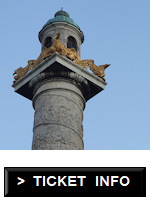A church with plenty to offer the visitor; Karlskirche (St. Charles’ church) has Baroque beauty, classical music, and a rare chance to go out onto an ecclesiastical rooftop with panorama views.
- 18th-century church built by Charles VI
- Stairs take you up to:
- a close-up look at the organ
- a large cutaway church model
- the treasury & panorama terrace
- Regular concerts by Ensemble 1756
- Look for a contemporary art bonus
- Book a Vivaldi concert* at the Karlskirche
- Inexpensive for Vienna
- See also:
St Charles Church
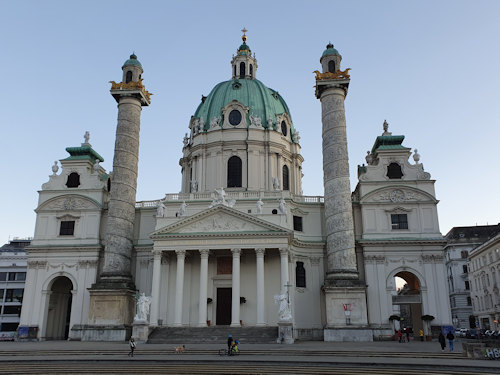
(Front view of the church)
Unlike most of Vienna’s gorgeous churches, Karlskirche can be approached from a distance as you walk across the open area before it.
The exterior architecture impresses with its great dome and the two giant columns. The latter’s reliefs and golden imperial eagles offer a clue to the history of the church, which Emperor Charles VI had built in the early 18th-century and named after Saint Charles Borromeo.
You need a ticket to enter outside of church needs and events (the revenue goes toward renovation work). But it’s very much worth doing so.
As you might expect from a Baroque place of worship, the inside glows with a smorgasbord of decorative delights…rich in marble stonework, wall paintings, reliefs, statues, scroll work and carvings, with regular splashes of gold. And all in beautiful condition.
Karlskirche is more subtle than some of its over-exuberant colleagues, though, with enough white space to give the senses a rest now and then.
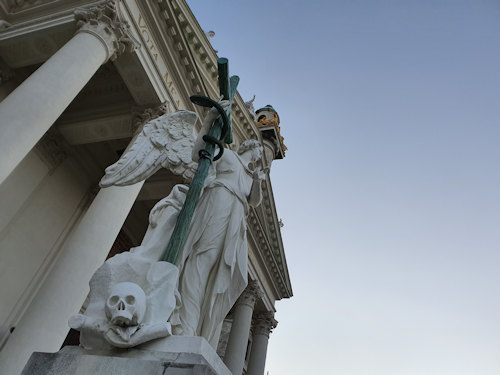
(One of the many hints at mortality thanks to the building’s origins in times of plague)
The nave sometimes has a huge art installation, designed to form a bridge or dialogue between contemporary art and the Baroque surrounds.
The Karlskirche Contemporary Arts programme that organises, curates and finances the installation began with Tomás Saraceno’s quite spectacular Aerocene back in 2019-2020.
The second installation (by renowned British artist Cerith Wyn Evans) went up at the end of January 2024. I don’t have an end date for the installation at the time of writing.
Forms through folds (ascending) measures 25m by 15m with around 700m of neon lighting in 350 individual glass pieces.
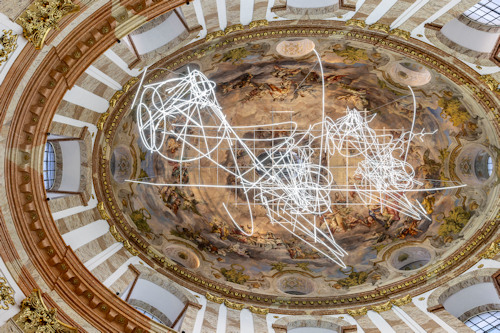
(Forms through folds (ascending) by Cerith Wyn Evans. An installation within the Karlskirche Contemporary Arts programme; press photo by and © Leonhard Hilzensauer)
Concerts
As with many of Vienna’s great churches, the Karlskirche acoustics and ambience lend themselves to classical concerts: the Ensemble 1756 performs* Vivaldi’s Four Seasons here.
That very composer is buried just a few yards away: a commemorative plaque on the TU Wien entrance diagonally opposite the front of Karlskirche marks the nearby grave of Vivaldi (now buried under the university buildings).
The ensemble was founded in 2006 in Salzburg, where 1756 has a special resonance. Wolfgang Amadeus Mozart was born in the city that year; 2006 would have been his 250th birthday.
Beyond the interior
Apart from the lower nave area, the church has an additional triple treat for visitors, accessed via a spiral stone staircase just past the ticket counter…
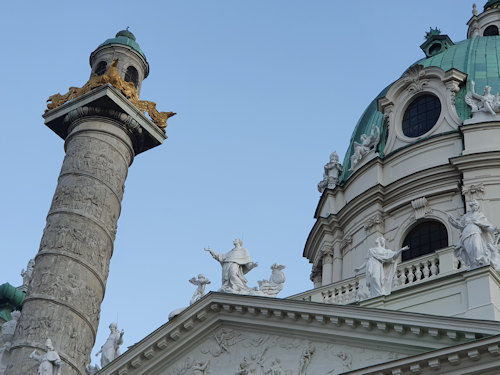
(The column on the left is covered in narrative reliefs)
1. Church model and organ
The first stop is a large cutaway model of the church with some historical architectural drawings associated with its construction.
(Tip: in early 2024, the neighbouring Wien Museum has a special exhibition on the life and work of Johann Bernhard Fischer von Erlach, the Baroque architect who also designed the Karlskirche.)
That same level lets you into the balcony home of the giant organ; the central part dates back to 1739 with the wings added in 1847.
The balcony gives lovely views down the church interior, also revealing the oval design of the pews.
2. The treasury
The next level has a small display that includes, for example, a silk mitre with gold lamé; documents suggest it belonged to Charles Borromeo himself.
This treasury room also holds such jewels as a 15th-century choir cape and 18th-century reliquaries, one of which (allegedly) contains wood particles from the cross.
3. The panorama terrace
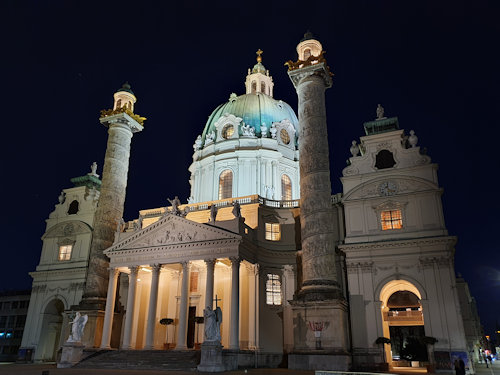
(The view at night)
The top of the stairs leads out to a small terrace right above the huge portal. You can spot the bannisters in the photo above.
From this height, you can see the Musikverein building and new Wien Museum off to the side of Karlsplatz, but also catch glimpses of Stephansdom cathedral, the domes of the Kunsthistorisches and Naturhistorisches museums, the top of the Rathaus tower, the DC Tower, and more.
You also get a closer look at the reliefs and eagles on those giant columns and a view across the park; this must be rather lovely during the Advent season, when the Art Advent Christmas market occupies the area in front of the church.
The market makes for great photos from below, too, with its lighted stalls and the Karlskirche backdrop.
Tickets & visitor tips
For concerts
The Ensemble 1756 usually puts on concerts several times a week, depending on the season.
(Booking service provided by Tiqets.com*, who I am an affiliate of)
(Nothing on your dates? Try some alternative concerts*)
For visiting Karlskirche
On my last visit, a standard adult ticket to view the church cost €9.50. I bought my ticket at the entrance, which is around to the right as you face the front of the church.
- As you buy your ticket, look to the right for a plaque commemorating the funeral of Anton Bruckner in the Karlskirche on October 14th, 1896
- For a little architectural bonus, pop across the park to the station pavilions built by Otto Wagner. Not quite Karlskirche in scale, but excellent examples of Jugendstil design
- And for an additional classical music bonus, the Brahms monument lies just across from the church
How to get to the Karlskirche
The church is within walking distance of the very centre of town, but might be one of the easiest sites to reach by public transport.
Subway: Karlskirche sits more or less above Karlsplatz subway station, where the U2, U1 and U4 lines intersect. Look for exits to Resselpark.
Tram/bus: numerous trams travel to Karlsplatz or the Karlsplatz/Oper stop, including those that skirt the old town – lines 1, 2, D and 71
Address: Kreuzherrengasse 1, 1040 | Website
